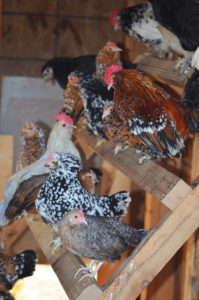
Bantams come in an array of colorful exotic feather patterns.
Chicken Craze
There is a chicken craze taking place, backyard flocks popping up everywhere, seems to be the trend. Many folks in rural and in city dwellings are establishing their own backyard flocks. Cities are changing their ordinances to allow people to own chickens. With chickens being reasonably inexpensive to own, folks everywhere are adapting to these birds of a feather for fresh meat and eggs. Raising chickens is fueling the aspiration for self-sufficient living, providing your family with better quality food, devoid of chemicals and hormones.
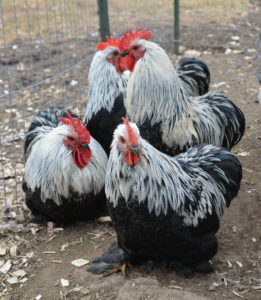
Beautiful Birchen Cochin Bantams
Choosing Your Chicken Type
So what is the best type of chicken to add to your flock? There are two basic types of chickens, large fowl, and bantam. Large fowl are standard chickens weighing 4+ pounds. Bantams are miniature chickens that weigh 1-3 pounds. Most folks tend to go with large fowl because they want the larger eggs. It is true bantams do lay a smaller egg, but these amazing little birds should not be overlooked, as they offer some surprising advantages over their larger counterparts.
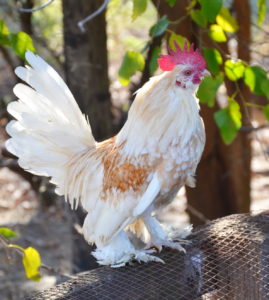
d’Uccle Gold Neck Bantam feathered legged, “true bantam”
Advantages of Owning Bantams
Bantams are rewarding to own because they are excellent layers and have the sweetest personalities. They are curious by nature and apt to greet you and follow you around the yard. They can become affectionate and will easily connect to their owners. Bantam roosters are sometimes referred to as the pit bulls of the chicken world, making exceptional protectors of their flock, and will fight to the death to ward off predators. Bantam hens are delightful and often friendly, making good pets for kids and adults alike. Bantams are famous for showing and they make ideal 4H and FFA projects because of their smaller size; they are much easier to handle, especially for younger children. Bantams eat about half as much and require about half the space of a large fowl. They are winter hardy and make excellent foragers when free ranged. Free ranged chickens mean you will buy less feed and save money. Bantam hens make excellent mothers and are more likely to go broody than large fowl hens, allowing you to have a self-sustainable flock. It is quite easy to take fertilized eggs from your large fowl hens and place them under a broody bantam, to hatch chicks. A bantam hen can easily incubate 4-7 large fowl eggs or 6-9 bantam eggs depending on her size. Bantams come in many colors with exotic feather patterns; they are popular with hobbyists, who like collecting them and showing them in the increasing number of popular poultry shows.
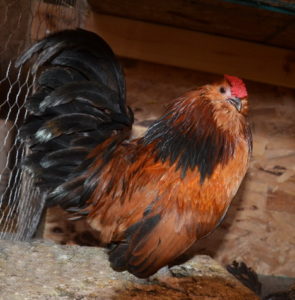
Quail Belgian Bearded d’Anver bantam, a clean legged ” true bantam”
Two Categories of Bantams
Most large fowl breeds have a bantam version, which is a miniature version of the large fowl, they are identical in appearance, except much smaller. The second type is a “true bantam,” which is naturally small and does not have a larger counterpart. Good examples of “true bantams” are Seabright, D’Uccles, and D’Anvers, they are all naturally small and do not have a large fowl equivalent. There are two classes of bantams, those with feathers on their legs called feathered legged, and those with no feathers called clean legged.
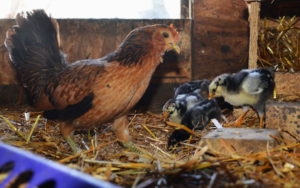
Belgian Quail d’Anver hen with large fowl Silver Laced Wyandotte chicks.
Profit with Bantams
Hatching and selling bantams can be fun and lucrative, and they have a much higher profit potential over large fowl because they eat less and need less space. Bantams raised from chicks will reach maturity in 7-12 months, with feed costs of roughly $8-10 per bird per year. Because of the growing demand for chickens in general, poultry auctions are becoming more common. At poultry auctions quality bantams will sell for top dollar, getting as much as $20 to $50 each. You will receive the highest dollar when selling them as a pair, a male, and female around one year of age.
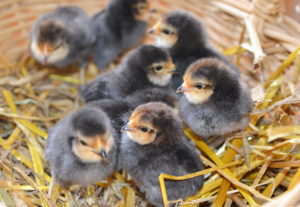
Newly hatched tiny Belgian quail d’Anver bantam chicks.
Bantams are charming little chickens to own, with many advantages over their larger counterparts. They can contribute many beneficial uses and can stand up on their own, making them an ideal addition to any backyard or homestead. You may wonder are there any cons for owning bantams? Well maybe one, they lay smaller eggs, but who cares, eat two!
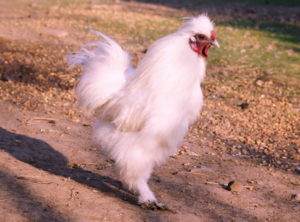
Exotic white Silkie bantam rooster, known to bring top dollar at poultry auctions.










